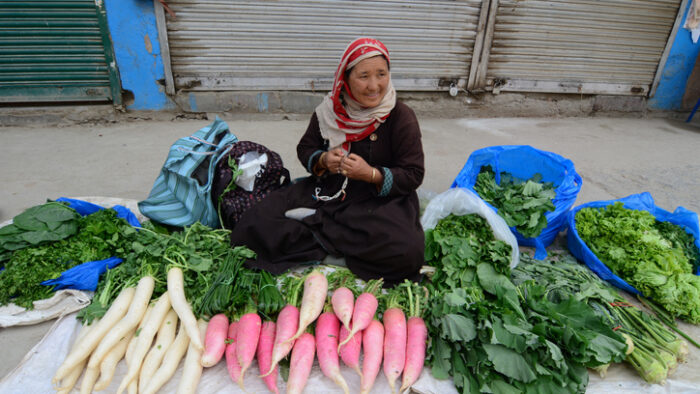Ladakhi Cuisine is characterised by its breads, soups, pastas and the vegetables that Ladakhis use in their fresh and sun-dried form
The highest cold desert of India, Ladakh despite its harsh winters does throw open amazing options to vegetarians
Flanked on most sides by mountains – the Karakoram Range in the North, Himalayas in the South and West, and sharing the borders with Tibet in the West, China and Lahaul and Spiti Valley of Himachal Pradesh – Ladakh has many influences on its cuisine. While some agriculture happens during the spring and the warm days, rest of the year is cold and dry, and nothing grows. This contrast is addressed in the food habits of the region, where diet follows the seasons.

Wheat & Barley & Other Vegetables
Wheat and Barley are the major cereals in Ladakhi cuisine, and a variety of greens and vegetables like radish, peas and napa cabbage that grow here in addition to tomatoes, apricots and even apple are used in the cooking in their fresh and sun-dried forms. While the region has its share of meat dishes – it is interesting to note that the cuisine has abundance of healthy vegetarian options traditionally like every Indian cuisine. “In fact, there are three auspicious days in a month when we do not cook meat at home and even at restaurants, we are not allowed to serve meat,” shares Nilza Wangmo, Ladakhi chef and owner, Alchi Kitchen.

Alchi Kitchen and Nilza Wangmo
Restaurateur Nilza Wangmo, recipient of the highest civilian honour for women in India - Nari Shakti Puraskar, has been promoting Ladakhi cuisine at her restaurant and on her many travels across India. Her restaurant is at Alchi village in Sham valley, lower Ladakh, where there is a 1000-year-old monastry. At the restaurant you will find the popular Ladakhi dishes including khambir and paba, bow-tie pasta skew, chutage, thukpa and tangtur.
Nilza loves to revive old recipes, and uses a whole lot of vegetables while recreating traditional dishes. “In addition to barley and wheat, we do grow root vegetables like turnip, radish, carrots etc., for the two - three months when it is warm. However, this year its September and the heat continues, so we are growing kaddu, water melon and other exotic vegetable like zucchini,” she states.

Floral Diversity of Ladakh
Pal Murugan M, Janifer Raj. X, Phani Kumar G, Sunil Gupta & Shashi Bala Singh from Defence Institute of High Altitude Research, Defence Research and Development Organisation (DRDO), who have researched on the traditional wild edible plants in Nubra valley, Ladakh submitted a paper ‘Phytofoods of Nubra Valley’ in 2008. They later published the findings in the Indian Journal of Traditional Knowledge in 2010.
According to them ‘Nubra, one of the valleys of Ladakh is known for its floral diversity in the cold arid zone. Twenty seven high altitude plant species belonging to 18 families in Nubra valley were identified as edible plants and used for the preparation of Ladakhi dishes. Shangso chonma, Ldum chonma, Thanthour chonma, Kabra chonma and Phololing chamyk were some of the famous traditional Ladakhi food item prepared from the wild edible plants.”


Role of Leafy Vegetables in Ladakhi Cuisine
Nilza on her part does use a lot of the wild greens in her cooking. “In addition to spinach, we go and pick a whole lot of wild greens like Caper Leaves, Nettle Leaves, Shangsho. There is also sholo, which grows only in hilly mountains. We cannot cook Sholo directly as it is bitter. We have to soak it in water for a couple of days for bitterness to go.
Then there’s wild mint, wild chives, which we use for tempering in the sun-dried version, and dandelion that grows in abundance. There are the conical leaves of Khalla, which taste like the Karela. Most of these greens grow in April, May and June. These days people are growing them in green houses, but I like to pick them from the wild,” she adds.

The Preserving Techniques
During the cold months when vegetables begin to stop growing the age-old tradition of sun drying comes handy. Nilza takes pride in preserving her vegetables by sun drying and also making jams and using them at Alchi Kitchen. “I even started sun drying the new exotic vegetables. I sun dried Zucchini and it turned out beautiful. Traditionally, we sundry most vegetables and that includes leafy vegetables and apples. We begin doing this around September. We make tikkis out of chives. Because of the dry weather, it doesn’t get moist. We break it into small pieces, and use it in raita for tempering throughout the year.”
Apricots begin to blossom in April and May depending upon the area where you stay. By end of July and August they ripen. And, then apple season begins. In addition to making jams I sun dry the fruits. We even make apple flour that can be used as porridge.”
The Hearty Soups
In Ladakh dishes are cooked according to the weather. During winters the warms soups are preferred which are meal on their own. They are quite hearty and wholesome and use a lot of vegetables. For example, the nettle soup, chanthuk and Pathuk.
Nilza shares a few recipes, “All grain soup with yak cheese and butter- chanthuk is made using both barley and wheat flour boiled with shranma (indigenous peas) and nag-shran (indigenous black peas). It gives instant warmth and energy. Pathuk on the other hand is pasta cooked with sun dried greens and vegetables, peas, labuk (pink coloured radish), and finished with a tadka of dry chives and wild cumin (caraway seeds). There is some cheese that goes into this dish. In the lower regions we use cow cheese, but in higher parts of Ladakh Yak cheese is used.”

Breads & Pasta
Eating bread with soup or by dipping it in butter tea is a common practice in Ladakh and the wonderful breads are mostly made using buck wheat or barley or both. Fermented khambir is one such bread eaten for breakfast along with butter tea.
Nilza tells us about yet another popular combination Paba and Tangtur. “Paba is a doughy porridge made by boiling mixed flour in water to a thick consistency. The flour is a combination of wheat, buck wheat, barley and turtle beans and brown beans. Once boiled this is pressed into triangular shape and it tastes best with Tangtur – lassi with green vegetables that are parboiled and chopped. Apple flour porridge or just the barley flour porridge too is had with tea/ lassi in the summer months.”

The traditional pastas of Ladakh are always prepared using seasonal vegetables. Meat is just an option. Oskew, the milk-based pasta, Skyu minus the milk, and Chutagi - the bow tie pasta is made flavourful by adding the unique greens and seasonal vegetables in their dried and fresh form. The buck wheat crepe that people usually eat with dal or a curry as side dish and even butter tea is yet another popular preparation, which along with its sweeter version are served at Alchi’s kitchen.
Nilza’s apricot jams are home-made, and yet another way to preserve the natural produce in order make them available through the winter months as well. Fresh apricots make for a great after meal dessert time fruit. During the summers dried apricot is soaked in water before eating. Desserts too are simple. Sample this – wheat flour balls poached in water, drained, sautéed in butter, sugar or honey and yak cheese powder added to it. Paktsa Marku is buttery, mildly sweet and tasty.
The elaborate overview of Ladakhi cuisine is a testimony to simplicity and uniqueness of traditional Indian cuisines. While the introduction of rice in the recent years has influenced the diet with the younger generation adapting newer food habits, places like Alchi Kitchen hold the flag for Ladhaki cuisine that is simple, wholesome and nutritious.





